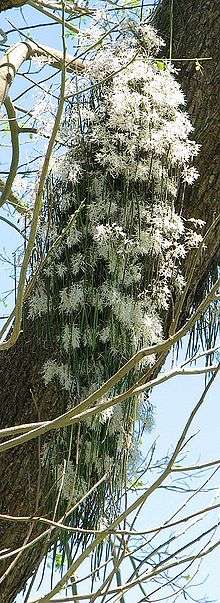Dockrillia
| Dockrillia | |
|---|---|
 | |
| Dockrillia teretifolia | |
| Scientific classification | |
| Kingdom: | Plantae |
| (unranked): | Angiosperms |
| (unranked): | Monocots |
| Order: | Asparagales |
| Family: | Orchidaceae |
| Subfamily: | Epidendroideae |
| Tribe: | Dendrobieae |
| Subtribe: | Dendrobiinae |
| Genus: | Dockrillia Briegar, 1981 |
| Species | |
|
approx 28 species, including:
| |
All terete leaved Dendrobium species from Australia and Papua New Guinea have been moved into a newly created genus, Dockrillia, named after Alick Dockrill, a contemporary Australian orchidologist. Dockrillia are ephiphytic or lithophytic plants, and found mainly along the east coast of Australia.
- "The genus was recently reinstated as distinct from Dendrobium based on absence of pseudobulbs, single fleshy leaf terminal on a short stem, multiflowered inflorescence arising from near the base of a leaf and flowers with a 3-lobed labellum. Pollination by native bees."[1]
- "Although the name Dockrillia was established as far back as 1981, it is only in recent years that the name has been resurrected. The genus Dockrillia has been split off from Dendrobium and comprises the "terete-leaved" group of "dendrobes". This revision has been generally accepted in Australia. Species in Dockrillia are characterised by succulent leaves which are rounded in cross-section (terete) and which arise from a creeping rhizome. Currently about 28 species are recognised. Dockrillia is named after Alick Dockrill."[2]
Current situation
The claim that Dockrillia is generally accepted in Australia is disputed. The Australian Orchid Council (AOC) follows the Checklist of Selected Plant Families accepted nomenclature and the RHS Hybrid Orchid Registration system, both of which list Dendrobium as the accepted genus and Dockrillia as a synonym. The major orchid growers association AOC and the AOC orchid judging system as well as the Australian National body for Australasian orchids, ANOS accepts Dockrillia as a synonym.[3]
There are about 29 species, 17 in Australia, with the others in Timor, New Guinea, New Caledonia, Vanuatu, Fiji, Samoa and Tahiti.[1]
Dockrillia crosses readily with Dendrobium to make Dockrilobium.
Most Dockrillia plants are easily propagated by rhizome division.
Selected species
- Dockrillia wassellii, the furrowed pencil orchid.
- Dockrillia cucumerina, the cucumber orchid, has leaves shaped like little cucumbers.
- Dockrillia linguiformis the tongue orchid - from Latin: lingua which means 'tongue', and formis which means 'shaped'. The thick and leathery leaves grow from a creeping rhizone, either as an epiphyte or as a lithophyte.
- Dockrillia pugioniformis, the dagger orchid, from the shape of its leaves. Plants can grow to very large specimens, often completely covering a large branch of a large tree.
- Dockrillia teretifolia, the pencil orchid, from the shape of its leaves. It has a pendulous growth and is sometimes known as the bridal veil orchid.
References
| Wikimedia Commons has media related to Dockrillia. |
- 1 2 A complete Guide to Native Orchids of Australia, including the island territories, p. 388. David L. Jones. 2006. New Holland Publishers, Frenchs Forest, N.S.W. 2086 Australia. ISBN 1-877069-12-4.
- ↑ Australian Plants Online. "What is a Dockrillia?"
- ↑ AOC